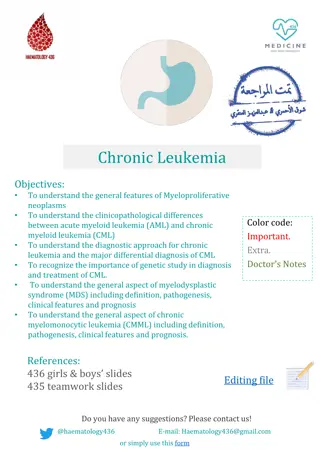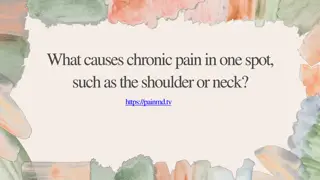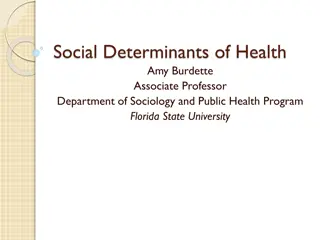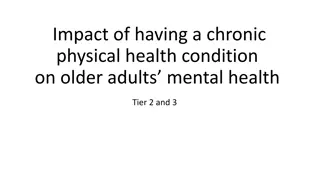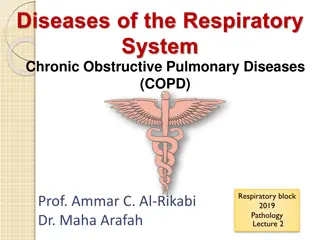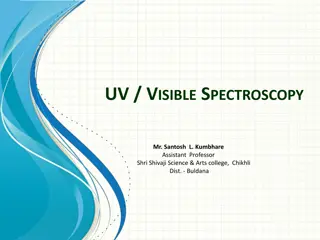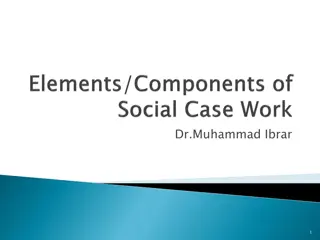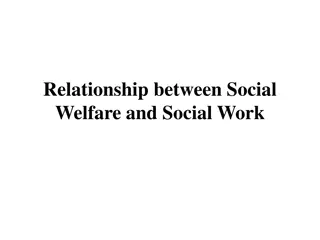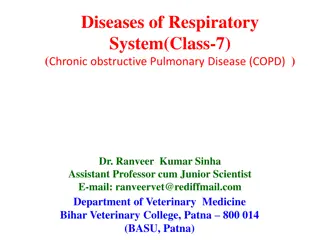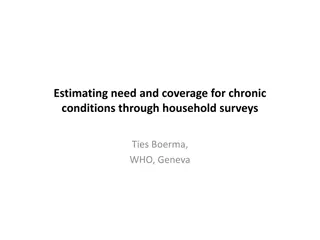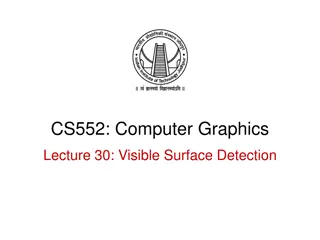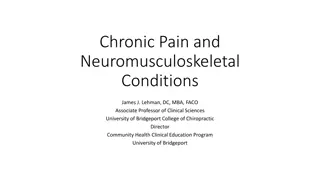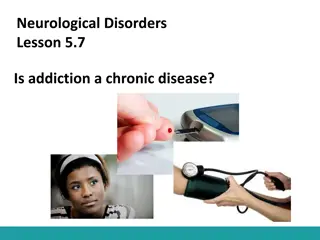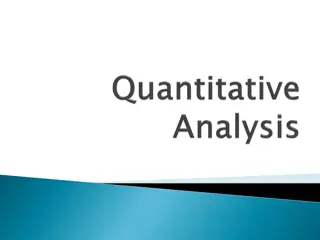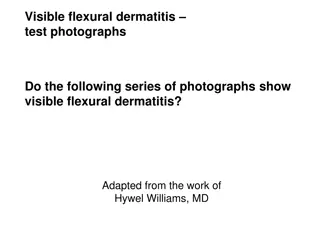Comprehensive Approach to Enhancing Social Functioning in Visible Chronic Conditions
This theoretical model explores the impact of visible chronic differences (VCDs) on individuals, emphasizing stigmatization and societal norms. It discusses the importance of social connection, highlights risks associated with VCDs, and presents the benefits of Functional Analytic Psychotherapy (FAP) in improving social functioning. The model considers the challenges faced by individuals with VCDs and suggests strategies for enhancing their quality of life.
Download Presentation

Please find below an Image/Link to download the presentation.
The content on the website is provided AS IS for your information and personal use only. It may not be sold, licensed, or shared on other websites without obtaining consent from the author.If you encounter any issues during the download, it is possible that the publisher has removed the file from their server.
You are allowed to download the files provided on this website for personal or commercial use, subject to the condition that they are used lawfully. All files are the property of their respective owners.
The content on the website is provided AS IS for your information and personal use only. It may not be sold, licensed, or shared on other websites without obtaining consent from the author.
E N D
Presentation Transcript
Using Awareness, Courage, and Love to Improve Social Functioning: A Theoretical Model to Improve the Lives of Those with Visible Chronic Conditions Joanna E. Dudek, M.A. Jonathan W. Kanter, Ph.D. Mavis Tsai, Ph.D. Adam M. Kuczynski, B.S. Pawe Ostaszewski, Ph.D.
What is a visible chronic difference (VCD)? any condition altering individual appearance in a way that is different from the perceived norm These differences can be: Congenital Acquired (e.g., chronic illness, accident, surgery) Lipedema Psoriasis Cleft palate Acne Burns Bessell, A., Dures, E., Semple, C., & Jackson, S. (2012). Addressing appearance-related distress across clinical conditions. British Journal of Nursing, 21(19), 1138 1143.
Why do VCDs matter to us? Stigmatization Sociocultural norms define acceptable appearance Evolutionary psychology: attractiveness is important in choosing potential partner The more visible and aesthetically displeasing the condition, the greater risk of stigmatization Unsolicited Discrimination Rejection Name calling Humiliation Devaluation Staring Disgust Aggression questioning Gilbert, P., & Miles, J. (Eds.). (2002). Body Shame: Conceptualisation, Research and Treatment. Hove, East Sussex: Routledge.
Stigmatization Shame Avoidance & Escape Social Isolation
Increase in odds of mortality due to various public health conditions 50 LONELINESS/NO SOCIAL CONNECTION Social connection is fundamental to health, well-being, and longevity and is identified as one of the most important public health problems 50 EXCESSIVE SMOKING 30 EXCESSIVE DRINKING 20 OBESITY AIR POLLUTION in the world. 5 0 10 20 30 40 50 60 Holt-Lunstad J, Smith TB, Layton JB (2010) Social Relationships and Mortality Risk: A Meta-analytic Review. PLoS Med 7(7): e1000316. doi:10.1371/journal.pmed.1000316
FAP maximizes the natural functional mechanisms of social connection in psychotherapy
ACL model of social functioning in people with VCD Problems and improvements defined by ACL language
The ACL Model Awareness Your present-moment self (your body, thoughts, feelings) Your values, needs, goals, identity The other: empathy Your impact on the other person Love Courage Acceptance, providing safety & reciprocal vulnerability Expressing understanding, empathy, and validation Giving others what they need (specific things) Providing closeness and connection Respecting boundaries Providing support, promising Providing feedback Receiving difficult feedback Expressing appreciation Expressing vulnerability and emotion Speaking your truth (speaking from the heart) Asking for what you need Closeness and Connection Setting boundaries Asking for support Asking for difficult feedback Giving difficult feedback Asking for appreciation Self-Love Acceptance of yourself (awareness, self-compassion) Accepting caring and loving feelings from others Cultivating positive feelings in yourself (appreciations, pride) Self-care (activities that soothe, calm, rejuvenate, recharge, or bring pleasure)
A,C&L deficits in people with VCD Awareness Paying attention only to some parts of experience (for example hyperfocused on their bodies or self- stigmatizing thougts or/and ignoring certain feelings, impact on others, during an interpersonal interaction) Missing or misinterpret signals of attention and care
A,C&L deficits in people with VCD Awareness Paying attention only to some parts of experience (for example hyperfocused on their bodies or self- stigmatizing thougts or/and ignoring certain feelings, impact on others, during an interpersonal interaction) Courage Avoiding social interactions, intimacy, and vulnerability due to fear of being hurt or rejected Ignoring or misinterpret signals of attention and care Behaving in a submissive ways (e.g. not expressing needs, no boundaries setting in relationships (e.g., to be accepted)
A,C&L deficits in people with VCD Awareness Paying attention only to some parts of experience (for example hyperfocused on their bodies or self- stigmatizing thougts or/and ignoring certain feelings, impact on others, during an interpersonal interaction) Courage Avoiding social interactions, intimacy, and vulnerability due to fear of being hurt or rejected Love Acting with hostility in order to protect themselves from being hurt Ignoring or misinterpret signals of attention and care Difficulties in responding with love to problems of people who don t have similar experiences Behaving in a submissive ways (e.g. not expressing needs, no boundaries setting in relationships (e.g., to be accepted)
A,C&L deficits in people with VCD Awareness Paying attention only to some parts of experience (for example hyperfocused on their bodies or self- stigmatizing thougts or/and ignoring certain feelings, impact on others, during an interpersonal interaction) Courage Avoiding social interactions, intimacy, and vulnerability due to fear of being hurt or rejected Love Acting with hostility in order to protect themselves from being hurt Ignoring or misinterpret signals of attention and care Difficulties in responding with love to problems of people who don t have similar experiences Behaving in a submissive ways (e.g. not expressing needs, no boundaries setting in relationships (e.g., to be accepted) Self-Love They may disregard their own needs and have difficulties with receiving love and help from others.
A,C&L improvements in people with VCD Awareness Noticing what is happening in their bodies - fear, disgust shame, and also love, curiosity, thoughts, inner sensations Recognizing their own needs and values, impact of their learning history Noticing and interpreting signals from other people (discriminating: signals of attention, care, interest; with whom they can take risks and self disclose, signals from others indicating that they are struggling too) Noticing how they impact others
A,C&L improvements in people with VCD Awareness Noticing what is happening in their bodies - fear, disgust shame, and also love, curiosity, thoughts, inner sensations Recognizing their own needs and values, , impact of their learning history Courage Engaging in social interactions, including new social interactions (expanding social network) Noticing and interpreting signals from other people (discriminating: signals of attention, care, interest; with whom they can take risks and self disclose, signals from others indicating that they are struggling too) Noticing how they impact others disclosing appropriately Initiating conversations, asking questions that build closeness, self- Engaging in interactions involving vulnerability, closeness, and trust Asking for what they need openly, tolerating conflicts, setting boundaries, and not engaging in violent relationships
A,C&L improvements in people with VCD Awareness Noticing what is happening in their bodies - fear, disgust shame, and also love, curiosity, thoughts, inner sensations Recognizing their own needs and values Noticing and interpreting signals from other people (discriminating: signals of attention, care, interest; with whom they can take risks and self disclose, signals from others indicating that they are struggling too) Noticing how they impact others Initiating conversations, asking questions that build closeness, self- disclosing appropriately Love Courage Giving positive feedback, giving appreciation Acting with empathy and love towards people even if they don t share similar painful experiences Being open to different interpretations of others reactions Shaping others behaviors (i.e., reinforcing desired pro-social responses in others); modeling awareness, courage, and love; actively building a social support network Engaging in social interactions, including new social interactions (expanding social network) Engaging in interactions involving vulnerability, closeness, and trust Asking for what they need openly, tolerating conflicts, setting boundaries, and not engaging in violent relationships
A,C&L improvements in people with VCD Awareness Noticing what is happening in their bodies - fear, disgust shame, and also love, curiosity, thoughts, inner sensations Recognizing their own needs and values Noticing and interpreting signals from other people (discriminating: signals of attention, care, interest; with whom they can take risks and self disclose, signals from others indicating that they are struggling too) Noticing how they impact others Initiating conversations, asking questions that build closeness, self- disclosing appropriately Love Courage Giving positive feedback, giving appreciation Acting with empathy and love towards people even if they don t share similar painful experiences Being open to different interpretations of others reactions shaping others behaviors (i.e., reinforcing desired pro-social responses in others); modeling awareness, courage, and love; actively building a social support network to own needs, self-care, body care (healthy habits) Engaging in social interactions, including new social interactions (expanding social network) Self-Love Self-appreciation when lacking reinforcement from others, self-pride Receiving love and care from others Showing self-compassion, attending Engaging in interactions involving vulnerability, closeness, and trust Asking for what they need openly, tolerating conflicts, setting boundaries, and not engaging in violent relationships
All these behaviors have in-session behavioral indicators (CRBs)
During FAP intervention we focus on increasing CRB2s and generalizing these improvements outside the session
Intervention Awareness Love Courage Self-Love
Example Title/reading/discussion A C L SL Your body is a brush that you paint your life with (reading before session) Mindful attention to the body, body related stories, shame Sharing shameful memories, feelings, and moments of stigmatization about the body Answering with love, validation, vulnerable sharing What does my body need to be nurtured and loved? Homework: ACL log
A deep sense of love and belonging is an irreducible need of all people. We are biologically, cognitively, physically, and spiritually wired to love, to be loved, and to belong. When those needs are not met, we don't function as we were meant to. We break. We fall apart. We numb. We ache. We hurt others. We get sick. -Brene Brown
Thank you joannaedudek@gmail.com




